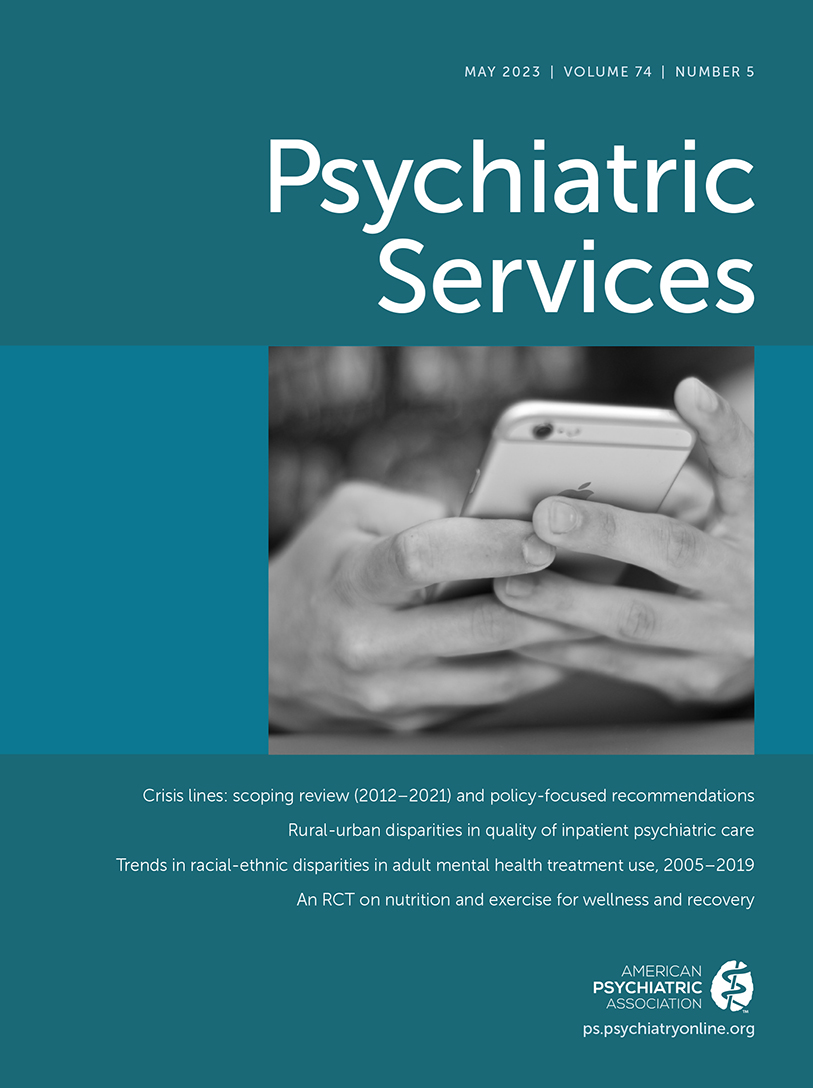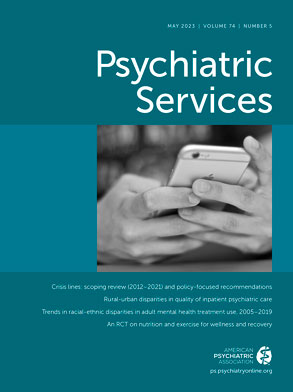Severe mental illness, such as psychotic, affective, or severe personality disorders, is characterized by chronic symptoms that fluctuate in severity and attributes and therefore require an agile and responsive therapeutic system in which continuity of care is a major focus. The interval between discharge from a hospital and readmission to ambulatory treatment is a critical transition period, gaps in which are associated with increased risks for rehospitalization (
1,
2) and suicide (
3) and a decrease in quality of life (
4). Admission to a new clinical care setting (or a previously familiar, yet somewhat altered, team) requires a period for building trust between patient and provider and for providers to familiarize themselves with the patient’s pharmacological, psychiatric, and social histories—a period during which the patient may regress. This process also consumes valuable resources and risks loss of information gathered during hospitalization.
In accordance with the regulations of Israeli law, all citizens are covered by public medical insurance. Hence, the patient does not pay any fee for admission to a psychiatric ward or psychiatric ambulatory service. Hospitalization in a mental health center (MHC) is allocated according to the patient’s home address (11 MHCs cover all state areas, and each provides services for a population of 850,000 citizens), and ambulatory services are selected according to the patient’s preference. A key component of clinical care is providing the patient with rehabilitation services, which in Israel are approved by a rehabilitation committee (
5) and paid for by the ministry of health. Rehabilitation programs require that the patient be motivated and stable, characteristics that often are achieved toward the end of hospitalization and may be lost or delayed by slow readmission to outpatient care.
A Pilot Continuity Project
The importance of continuity of care prompted our MHC to conduct a pilot continuity-of-care project in one of our three acute inpatient wards. We appointed a senior psychiatrist who equally divided his time between the inpatient ward and the MHC’s outpatient clinic. His assignment was to tend to patients with severe mental illness before discharge and continue their outpatient care, relaying their status to the paramedical outpatient clinic staff. Over time, the patients who had successfully acclimated to the community and had a reduced odds of rehospitalization could be transferred to the care of another psychiatrist (working with the same paramedical staff).
Methods
The aim of this study was to assess the impact of the pilot continuity-of-care model on common quality-of-care measures among hospitalized patients with severe mental illness. The model was implemented on July 1, 2018, and expanded thereafter. The impact of the model on care outcomes was evaluated retrospectively with several measures of quality of psychiatric care: length of hospitalization, number of visits to psychiatric emergency departments (EDs), time for admission to clinical care after hospital discharge, rate of consensual hospitalizations versus compulsory admissions, and entry into rehabilitation. These measures were compared between patients with severe mental illness before and after the implementation of the continuity-of-care model in the pilot ward and with those of patients on the other acute wards that did not implement the model. The study was approved by the Shalvata Institutional Review Board.
For most measurements, we compared data regarding all patients hospitalized during the year before model implementation (July 1, 2017–June 30, 2018; N=259 patients) or in the year following implementation (July 1, 2019–June 30, 2020; N=313 patients). Comparison of rehabilitation outcomes between wards was assessed for a 20-month period, starting January 2019. Data were collected from the hospital’s computerized systems and from the statistical reports required by the Israeli Ministry of Health. The reliability of the data was very high, because all systems were computerized and the analyses were part of the standard of care in our MHC. For comparison of quantitative data, t tests and chi-square tests were performed, and for comparison of means, t tests were performed. All analyses were conducted in SPSS, version 21.0.
Results
In the year before the implementation of the continuity-of-care model (July 1, 2017–June 30, 2018), 259 patients (N=168 [65%] males) were discharged from the ward, of whom 171 (66%) had a major diagnosis of psychotic disorder, 28 (11%) an affective disorder, and 23 (9%) a severe personality disorder. Overall, 48 patients (19%) had a comorbid substance use disorder. In the year after model implementation (July 1, 2019–June 30, 2020), 313 patients (N=194 [62%] males) were discharged, of whom 197 (63%) had a major diagnosis of psychotic disorder, 39 (12%) an affective disorder, and 31 (10%) a severe personality disorder; 67 (21%) of these patients had a comorbid substance use disorder.
We observed no statistically significant between-group differences in sex, primary psychiatric diagnosis, or comorbid substance use disorder. All patients were insured by one of four Israeli HMOs. In the year after model implementation, 247 (79%) of the 313 discharged patients continued their ambulatory follow-up in the continuity-of-care clinic. The numbers of repeat hospitalizations and other events for patients hospitalized 1 year before implementation of the model were compared with those occurring in the year after implementation; the main differences between the 2 years are presented in
Table 1. We observed a significant decline both in visits to the ED (41% vs. 28%, a 32% decrease, p=0.001) and in rehospitalizations within 30 days (20% vs. 12%, a 40% decrease, p=0.006) and 90 days (28% vs. 20%, a 29% decrease, p=0.019) of discharge.
We also compared the rate of consensual versus compulsory hospital admissions both for inpatients in the continuity-of-care ward before and after implementation of the model and for the patients in this ward versus those in the other acute MHC wards after model implementation. We noted a significant 29% reduction in compulsory admissions in the pilot ward from pre- to postimplementation (from 35% to 25%). Compared with other acute wards, the continuity-of-care ward had a lower rate of compulsory admissions in the postimplementation period (30% [N=145 of 488] vs. 25% [79 of 313], respectively), but this difference was not statistically significant.
Time to admission to an outpatient clinic after discharge was significantly shorter after implementation of the continuity-of-care model compared with length of admission time at other wards (mean±SD=22.9±6.4 days vs. 28.3±7.2 days, respectively, a mean difference of 8.5 days, p=0.001). Finally, we compared rates of patients with severe mental illness who underwent rehabilitation (either during hospitalization or in outpatient settings after discharge) between the continuity-of-care ward and the other wards. Between January 1, 2019, and August 31, 2020, the proportion of patients who entered rehabilitation from the continuity-of-care ward (13%, N=49 of 366 patients) was significantly higher than that among patients from the other wards (9%, N=60 of 695 patients) (p=0.004). This difference was maintained when we focused on outpatients alone: 11 patients from the continuity-of-care ward versus four patients from the other wards (χ2=10.15, df=1, p=0.001).
Discussion
We found that after the implementation of the inpatient-outpatient continuity-of-care model, ED visits and the rates of rehospitalizations significantly declined, as did rates of compulsory admissions to the continuity-of-care ward. Compared with outcomes in other acute wards in the MHC, time to outpatient clinic admission was significantly shorter and significantly higher rates of patients entered rehabilitation after implementation of the new model.
The significant reduction in the rate of ED visits and rehospitalizations might reflect better quality of care for patients with severe mental illness postdischarge in the continuity-of-care model. We hypothesize that the familiarity of the “continuity-of-care physician” with patients played a significant role in this reduction. Aside from this positive direct effect on patients, reduction of repeat visits to the ED enabled the ED staff to allocate its resources to other patients.
Another important finding was a decrease in involuntary hospitalizations. Even when compulsory hospitalizations are possible, consensual admissions are preferable, because cooperation between patient and provider is likely to enhance clinical responses. The observed increase in consensual admissions among patients in the continuity-of-care model might reflect both enhanced familiarity of providers with their patients’ history, allowing for early detection of problems, and a trusting relationship of the patient with the provider, which allows proactive intervention. Consensual hospitalization contributes to a reduction in violence and to a more positive atmosphere for both inpatients and ward staff.
An additional quality measure was the rate of patients who entered rehabilitation. In 2018, a total of 3,434 (3.1%) of an estimated 110,000 patients with severe mental illness in Israel were referred to rehabilitation committees (
6). Thus, in the period studied (20 months), we expected that 5.2% of discharged patients would be referred to rehabilitation. We found that 13% of the patients discharged from the continuity-of-care ward were referred to the committee (vs. 9% from other wards), more than double the expected rate. We speculate that continued care may make it easier to initiate and complete the rehabilitation process. Hospitalizations might be shorter when the ward staff knows that rehabilitation will commence after discharge, but this supposition requires further study.
The main limitation of this study was the existence of possible confounders between the continuity-of-care ward and the control wards. These confounders might include the specific persona of the appointed continuity-of-care physician and differences in attitudes to psychiatric care among staff in the wards examined. Another significant confounder, especially regarding ED visits, was the onset of the COVID-19 pandemic, which was declared in March 2020, overlapping the last 4 months of the comparison period. Slight inaccuracies of our results might have resulted from a few patients who were followed up elsewhere after discharge.
Conclusions
The findings of this study suggest that a continuity-of-care model that seeks to integrate inpatient and outpatient care through a continuity-of-care physician improves effectiveness of care. The rationale for this model was that an ongoing therapeutic relationship would improve trust, knowledge, and stability and thereby enhance treatment and that this improved treatment would be reflected in better quality-of-care outcomes. We found that implementation of the model was associated with reductions in the number of ED visits after discharge. We also noted that the model resulted in a reduced rate of compulsory (vs. consensual) admissions and in an increase in the rate of entry to the formal rehabilitation process.
We anticipate that an integrated care system cannot be based solely on one clinician (i.e., the continuity-of-care physician); therefore, we are currently integrating more paramedical therapists (e.g., occupational therapists and art therapists) into the care continuum. Furthermore, on the basis of these preliminary findings, we have extended the model to all acute wards in our MHC. Once we received approval for allocating resources to the continuity-of-care model (which had been the main barrier to its implementation), it became easier to recruit personnel, because most clinicians found the combination of inpatient and outpatient care highly appealing. However, we note the possibility of increased risk for burnout given that personnel in mental health systems face a heavy burden in their work, in part resulting from treatment of patients with severe mental illness in two settings (i.e., inpatient and outpatient) that sometimes have very different goals and modes of treatment. If the continuity-of-care model is proven effective as an operational model in the whole MHC, we will recommend its implementation in additional MHCs nationwide.
Acknowledgments
The authors thank the administration of the Shalvata hospital for enabling a process involving a major change in mindset for many practitioners and the ward staff who embraced the idea from the onset to its implementation. The authors also thank the patients in the ward.

